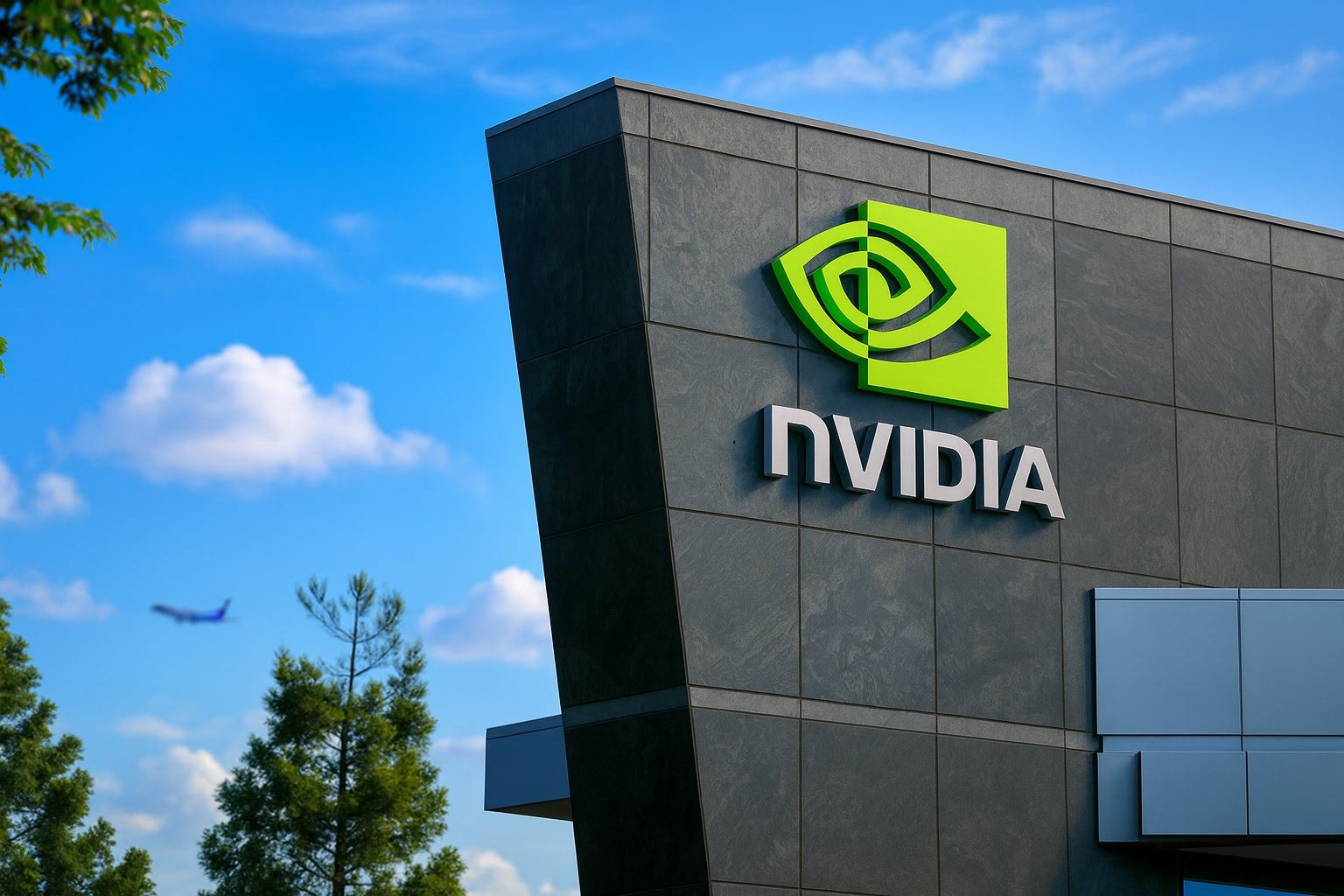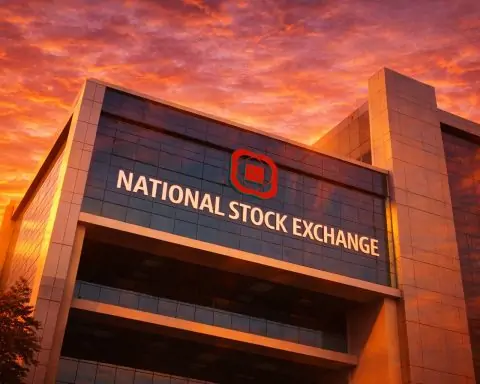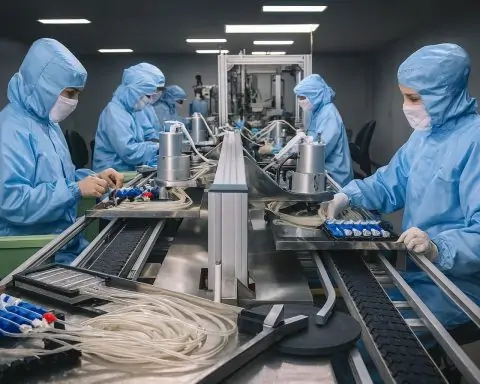- NVDA nears record highs: Nvidia’s stock is trading around $182 on Oct. 21, 2025 – just shy of its all-time peak (~$195) earlier this month [1]. Shares are up about 30% year-to-date, vastly outperforming the broader market [2].
- Mega AI deals fuel momentum: Nvidia unveiled blockbuster partnerships, including a $100 billion investment-and-chip supply pact with OpenAI, a $5 billion stake in Intel to co-develop processors, and joining a $40 billion consortium (with BlackRock, Microsoft, etc.) to acquire Aligned Data Centers [3]. These tie-ups expand Nvidia’s AI empire and sent NVDA stock jumping to new highs.
- China market share wiped out: U.S. export bans and Beijing’s tech crackdown have driven Nvidia’s share of China’s AI chip market from ~95% to 0%, according to CEO Jensen Huang [4]. “At the moment, we are 100% out of China,” Huang lamented, calling it a dire loss of one of the world’s largest markets [5]. Nvidia has removed China from its forecasts (assuming zero sales ahead) after once deriving up to 20–25% of its data-center revenue there [6].
- Earnings booming despite headwinds: Insatiable global demand for Nvidia’s AI chips drove a 56% revenue surge last quarter (FY2026 Q2) to $46.7 billion [7] – with a staggering $41 billion from data-center GPUs alone. Nvidia expects the growth to continue: it has forecast Q3 revenue of $54 billion (≈54% YoY growth, even excluding any high-end China sales) [8]. Another blowout quarter is anticipated when Nvidia reports on November 19, as AI hardware orders remain red-hot [9].
- Wall Street overwhelmingly bullish: Analysts remain upbeat that Nvidia’s AI leadership will outweigh geopolitical setbacks. 36 out of 38 analysts rate NVDA a “Buy,” with an average 12-month price target around $220–$225 – roughly 20–25% above current levels [10]. Some foresee even greater upside: HSBC recently upgraded Nvidia to “Buy” and nearly doubled its target to $320 (≈78% above market) citing explosive AI chip demand and NVIDIA’s expanding market opportunity [11].
- Big opportunities – and big risks: Nvidia’s dominance in AI silicon has made it one of the world’s most valuable companies, trading at ~50× earnings [12]. Optimists say “AI is the real deal” and view Nvidia as the premier play on the AI revolution [13]. Any thaw in U.S.–China tech tensions – for example, relaxing chip export curbs – could unlock new sales upside [14]. Yet high expectations leave little room for error: rising competition from AMD, sky-high valuation, or an AI spending slowdown could spark a sharp pullback if Nvidia ever stumbles [15].
NVDA Stock Near Record Highs in Volatile Market
Nvidia’s stock (NASDAQ: NVDA) has been on a rollercoaster this month, yet it remains near record levels. In early October, NVDA surged to an intraday all-time high around $195 [16] amid frenzied AI-driven buying. A mid-month pullback followed – the stock tumbled ~4% on profit-taking and macroeconomic jitters – but dip-buyers quickly stepped in [17]. By Oct. 21, NVDA was back around the low-$180s per share, only a few percent below its peak [18]. Year-to-date the stock has climbed about 30%, vastly outperforming the S&P 500, thanks to Nvidia’s status as the market’s premier “AI trade” [19].
This resilience comes despite broader tech volatility. Rising bond yields and other macro headwinds spooked growth stocks in mid-October, but investors continue to gravitate to Nvidia on any dips [20]. Heavy trading volumes (200+ million shares daily in mid-October) reflect intense interest in the name [21]. “High valuations and interest-rate jitters” sparked some profit-taking, one analyst noted, yet most see the pullback as a temporary breather for an otherwise strong uptrend [22]. At around 50× forward earnings [23], NVDA isn’t cheap, but believers argue its growth prospects justify a premium.
Short-term drivers: Major news events have been whipsawing the stock. In late September, Nvidia rallied on headlines of massive AI initiatives, then eased off as the initial euphoria cooled [24]. More recently, each development in the AI arena or chip policy has swung NVDA shares. For example, on Sept. 22 Nvidia announced an unprecedented partnership with OpenAI, sending the stock up 4.4% to a record high intraday [25] [26]. Conversely, indications of tighter U.S. export rules or rising global tensions have at times weighed on the stock. Overall, Nvidia’s proximity to its peak and its role as an AI bellwether keep it squarely in the spotlight.
Record Sales, New Chips, and a $100 Billion OpenAI Deal
Nvidia’s fundamentals are surging in tandem with the AI boom. In its latest quarter (Q2 FY2026 covering May–July 2025), revenue soared 56% year-on-year to $46.7 billion – an astonishing number for a company of Nvidia’s size [27]. Roughly 88% of that came from Nvidia’s data-center segment alone, as cloud giants and startups snapped up its AI accelerators to train large language models [28]. This unprecedented demand has sent Nvidia’s profitability soaring as well (gross margins are ~72%, with net margins over 50% [29]), turning the chipmaker into a cash machine.
Investors have rewarded Nvidia’s growth by bidding its market capitalization into the stratosphere. At times in early October, Nvidia’s market value briefly surpassed even Apple’s, making it the world’s most valuable company [30]. (Analysts estimate NVDA’s market cap around $450–500 billion at ~$180/share, though some commentary inaccurately pegged it near $4 trillion [31].) The exact figures aside, there’s no doubt Nvidia’s valuation has reached rarified heights. This has sparked debate on how much “AI hype” is baked into the price [32]. Bulls argue that Nvidia is capturing a once-in-a-generation tech shift (and point to its 30%+ expected revenue growth next year as justification). Bears counter that at 50+ times earnings, Nvidia is “priced for perfection” – any stumble could trigger a painful correction [33].
Big bets on AI infrastructure: Nvidia isn’t resting on its laurels – it’s cutting mega-deals to cement its dominance. In late September, the company stunned the market by agreeing to invest up to $100 billion in OpenAI and supply OpenAI with at least 10 gigawatts of its cutting-edge GPU systems [34] [35]. This tie-up links Nvidia with the maker of ChatGPT in a deep strategic partnership. As part of the proposed deal (currently a letter of intent), Nvidia will take non-voting equity in OpenAI, and OpenAI in turn will use the funding to purchase vast quantities of Nvidia’s AI chips [36] [37]. “Everything starts with compute,” OpenAI CEO Sam Altman said of the alliance – emphasizing that Nvidia’s hardware will underpin future AI breakthroughs [38]. Analysts were floored by the scale: one noted that “every gigawatt of AI data center capacity is worth about $50 billion in revenue”, implying the OpenAI partnership could translate into a $500 billion opportunity over time [39]. Nvidia’s stock spiked on the announcement [40], and rival chip stocks jumped in sympathy on optimism about AI spending [41].
Nvidia also struck a historic pact with Intel in mid-September – a surprise twist given the companies’ rivalry. It agreed to invest $5 billion for a roughly 4% stake in Intel and to jointly develop future CPU-GPU platforms [42] [43]. Under this alliance, Intel will manufacture custom x86 processors that tightly integrate with Nvidia’s GPUs (using Nvidia’s NVLink interconnect), effectively bridging Nvidia’s AI accelerators with Intel’s PC/server ecosystem [44]. Jensen Huang revealed he had been collaborating with Intel’s CEO on the plan for months. The news sent Intel’s own stock +23% in a day and lifted NVDA ~3.8% [45]. For Nvidia, partnering with Intel – the largest U.S. chipmaker – secures additional chip fabrication capacity and x86 expertise as it scales up AI “superchips.”
In another move to secure infrastructure, Nvidia joined forces with BlackRock, Microsoft and others to buy Aligned Data Centers for $40 billion [46]. Aligned operates ~80 data centers (5+ gigawatts of capacity) across the U.S. – precisely the kind of facilities needed to host Nvidia’s power-hungry AI hardware. The deal (announced Oct. 15) is expected to close in 2026 [47]. One portfolio manager summed up Nvidia’s strategy: “They’re looking at rapid expansion to meet AI demand” [48]. By locking in data-center capacity, Nvidia can ensure that as it sells more GPUs, clients have somewhere to put them. Similarly, Nvidia recently unveiled the first U.S.-made test wafer of its next-gen “Blackwell” AI chips – produced with TSMC at a new Arizona fab – highlighting efforts to onshore more production [49]. All of these initiatives are about scaling up supply in line with overwhelming demand.
Product innovation continues: Alongside big deals, Nvidia keeps rolling out new chips and systems. Just this month, it launched the Nvidia DGX Spark, billed as the “world’s smallest AI supercomputer.” Priced around $4,000, the DGX Spark is a compact desktop device delivering 1 petaFLOP of AI performance using a new Grace-Blackwell “GB10” Superchip co-designed with Taiwan’s MediaTek [50] [51]. This mini supercomputer lets developers fine-tune and run massive AI models (up to ~200 billion parameters) locally, using 128GB of unified memory and a 20-core Arm CPU alongside the latest Blackwell GPU [52]. It’s even efficient enough to plug into a standard wall outlet. The DGX Spark went on sale October 15 and exemplifies Nvidia’s push to broaden AI adoption beyond cloud data centers – essentially bringing AI compute to the desktop. Nvidia also refreshed its GeForce product line for gamers this fall (the RTX 50-series GPUs), incorporating AI enhancements to graphics and upscaling. From consumer PCs to corporate data centers, Nvidia is blanketing the market with new offerings – reinforcing why many see it as the “unquestioned leader” in AI chips [53].
China Crackdown: Nvidia’s 95% Market Share Falls to Zero
While Nvidia’s prospects in the West are soaring, its position in China has unraveled virtually overnight. CEO Jensen Huang revealed that Nvidia’s share of China’s advanced AI chip market has collapsed from roughly 95% to 0% due to geopolitical forces [54]. “We went from 95% market share to 0%,” Huang said at an event in early October, confirming that U.S. export restrictions have effectively wiped out Nvidia’s China business [55]. Since 2022, U.S. regulators have barred Nvidia from selling its most advanced GPUs (like the A100, H100 and newer H200) to Chinese customers, aiming to limit China’s AI capabilities [56]. Nvidia tried to adapt by offering slightly downgraded “China edition” chips (such as the A800 and H800) that met the export rules [57]. But Washington kept tightening the curbs – and Beijing responded with its own clampdowns.
By 2025, the situation reached a breaking point. In July, China’s Cyberspace Administration banned domestic tech giants from buying even Nvidia’s scaled-down chips that were technically allowed [58]. Firms like Alibaba and ByteDance were ordered to halt all tests and orders of Nvidia’s China-specific AI GPUs [59]. At the same time, Chinese chipmakers like Huawei (with its new AI accelerators) and startups like Cambricon rushed to fill the void, supported by Beijing’s push for semiconductor self-sufficiency [60]. The result: Nvidia’s presence in China has been annihilated. “At the moment, we are 100% out of China,” Huang said bluntly [61]. He has removed China entirely from Nvidia’s forward revenue guidance, assuming zero sales in the region going forward [62]. “If anything happens in China – which I hope it will – it’ll be a bonus,” Huang quipped, underscoring that any future China revenue is now just an upside optionality [63].
Huang has been sharply critical of U.S. policy in this saga. He characterized the strict chip export bans as a strategic mistake that ultimately harms American industry. “I can’t imagine any policymaker thinking that’s a good idea – that whatever policy we implemented caused America to lose one of the largest markets in the world to 0%,” Huang said of the outcome [64]. He warned that overly broad tech sanctions on China could “harm the U.S. and even worse” if they prompt China to develop self-reliant alternatives [65]. Indeed, we are now seeing exactly that: China is doubling down on indigenous chips, and Nvidia has lost its dominant position in what was once its second-largest market [66] [67]. Before the crackdown, China accounted for an estimated 20–25% of Nvidia’s data center revenues [68]. Even last fiscal year, Chinese customers still generated about 13% of Nvidia’s total sales [69]. That has now plummeted to virtually 0% – an astonishing reversal for a company that not long ago owned China’s AI computing space.
Beijing’s retaliation and tech decoupling: From China’s perspective, Nvidia’s loss is a deliberate gain for its nascent domestic semiconductor industry. After the U.S. blocked Nvidia’s top-tier chips, Beijing moved swiftly to bolster Chinese chipmakers and reduce reliance on American tech. Regulators not only forbid purchases of Nvidia parts; they also launched investigations into Nvidia. In September, China’s State Administration for Market Regulation (SAMR) accused Nvidia of violating anti-monopoly law, announcing a preliminary probe into the company [70] [71]. This antitrust threat – coming as U.S.-China trade talks were ongoing – was seen as a warning shot, signaling that China is willing to “inflict damage on U.S. companies” if tech tensions continue unabated [72]. Chinese officials even demanded Nvidia explain its new H20 chip (a high-end GPU custom-made for China) amid suspicions it could have hidden “backdoors” compromising Chinese data security [73].
In short, tech trade has become a geopolitical chess match, and Nvidia is caught in the middle. U.S. export controls aim to choke off China’s access to the best AI silicon, while China is responding with everything from import inspections to antitrust probes to prop up local alternatives [74] [75]. Earlier this month, the Financial Times reported Chinese customs officials have been dispatched to major ports to strictly enforce chip import rules, specifically scrutinizing Nvidia’s shipments (even the “safe” H20 and RTX 6000/6000D models) [76] [77]. That escalation came after reports that grey-market smuggling of Nvidia chips into China was rampant (over $1 billion worth of Nvidia’s top AI GPUs allegedly flooded into China in just three months via unofficial channels) [78]. In effect, Beijing is tightening the screws to ensure Nvidia’s advanced processors stay out, giving Chinese chip developers breathing room to catch up.
Despite these challenges, Nvidia’s global growth hasn’t missed a beat so far. The company and many analysts assert that demand elsewhere more than offsets the China gap [79]. In fact, Nvidia’s stock has continued climbing in 2025 – up roughly 30% this year after an eye-popping +171% gain in 2024 [80] – even with China essentially sidelined. Many investors view the China issue as containable: while China once contributed nearly a quarter of Nvidia’s data center revenue, that share fell to <6% by last quarter as U.S. restrictions took hold [81]. Nvidia’s sales are booming in the U.S., Europe and cloud providers globally, thanks to generative AI adoption, so the thinking is that losing China, though significant long-term, won’t derail the near-term growth story [82]. As one tech analyst put it, Nvidia remains the “unquestioned leader” in AI hardware despite the China setback [83], and any easing of U.S.-China tensions would simply be upside. On the other hand, if the tech Cold War deepens and Chinese rivals like Huawei start seriously closing the gap, Nvidia could feel more heat down the road [84]. For now, the company is effectively writing off China and focusing on serving the insatiable AI demand everywhere else.
Competition Heats Up: AMD, AI Rivals and Supply Constraints
Nvidia’s commanding lead in AI chips is no longer uncontested. Advanced Micro Devices (AMD) – long a distant second in GPUs – has made headline-grabbing moves this fall to muscle into the AI market. Earlier this month, AMD struck a blockbuster deal with OpenAI to supply its upcoming MI300-series and next-gen MI450 AI chips to power OpenAI’s workloads [85]. The multi-year agreement is huge: OpenAI could end up buying up to 6 gigawatts of AMD’s GPUs, and notably the deal even gives OpenAI an option to take an equity stake in AMD itself [86]. In a related win, Oracle announced it will deploy 50,000 of AMD’s MI450 accelerators in its cloud data centers starting in 2026 [87]. Oracle’s vote of confidence shows that big cloud customers are willing to consider Nvidia alternatives if they are competitive.
These developments won’t dethrone Nvidia overnight – its flagship H100 GPU remains the industry’s gold standard, and most AI models today are still trained on Nvidia silicon [88]. But the competitive landscape is undeniably heating up. AMD’s forthcoming MI300/MI450 chips, along with processors from startups like Graphcore and Google’s TPUs, signal that customers will soon have more choices. Even Nvidia’s largest cloud clients (e.g. Microsoft, Amazon, Google) have been developing or investing in custom AI chips to diversify their supply. Nvidia itself has started selling complete AI supercomputer systems (combining its own Grace CPUs with its GPUs) to lock customers into its ecosystem as others race to follow suit [89]. As the late 2020s unfold, the AI hardware market will likely become more crowded, which could eventually pressure Nvidia’s pricing power and margins [90]. For now, Nvidia’s performance advantage and software ecosystem (CUDA, AI libraries) keep most developers tied to its platform. But AMD’s resurgence – along with geopolitical forces nudging some buyers to “anything but Nvidia” – introduces a strategic risk that Nvidia must navigate.
Another challenge is simply meeting demand. The AI fervor has created chip shortages and supply-chain bottlenecks industry-wide. Nvidia’s high-end H100 GPUs are effectively sold out into next year, and customers face long lead times. The company is pouring capex into increasing output (working closely with TSMC, Samsung, and even Intel’s foundry down the line) to avoid leaving money on the table. Taiwan’s TSMC, which manufactures Nvidia’s chips, recently raised its sales forecast and reported record profits thanks to the AI chip boom lifting all boats [91]. Still, any hiccups in production – whether due to capacity constraints or disruptions (natural disasters, export controls on critical materials, etc.) – could slow Nvidia’s roll.
On the geopolitical front, aside from China, Nvidia is also adapting to shifting U.S. export policies in other regions. In a contrast to the China crackdown, the U.S. has been loosening restrictions for allies. Notably, Washington recently approved “several billion dollars” worth of Nvidia’s AI chip exports to the United Arab Emirates [92], as part of a bilateral AI cooperation deal. The license will reportedly allow the UAE to import up to 500,000 of Nvidia’s advanced chips per year starting in 2025 [93] – a significant volume destined for new AI research centers in the Gulf. This came after the UAE agreed to invest similarly in U.S. tech development [94]. Meanwhile in August, U.S. officials even floated the possibility of letting Nvidia sell more advanced GPUs to China (like the H100 or H20) under certain conditions [95]. In fact, U.S. authorities did authorize Nvidia to export its H20 chips to China if it surrendered 15% of those sales’ revenue to the U.S. government [96] – an unusual arrangement that so far has not resulted in any actual shipments, due to bureaucratic holdups on how that payment mechanism would work [97]. These nuanced policy shifts show that governments are carefully calibrating who gets access to Nvidia’s technology. For Nvidia, it means navigating an ever-complex map of where it can sell what without running afoul of rules.
The upcoming APEC summit in late October could be pivotal on this front. U.S. President and China’s President Xi Jinping are expected to meet during the forum, raising hopes for a thaw in the tech trade war [98]. Jensen Huang will also be attending APEC in Seoul to meet with industry leaders (including Samsung and SK Hynix executives) [99]. Any progress – say, an agreement to ease chip export curbs or grant Nvidia more leeway in China – would remove a major overhang on Nvidia’s future sales [100]. Conversely, if talks falter and each side doubles down on restrictions, Nvidia will remain caught in the crossfire. It’s a high-stakes balancing act for the company that enables everyone’s AI ambitions while getting squeezed between superpowers.
Wall Street’s View: Sky-High Expectations but Strong Earnings Momentum
Despite these risks, Wall Street’s consensus on Nvidia is resoundingly bullish. As one market analyst remarked, “AI is the real deal,” and Nvidia is widely seen as the premier way to invest in that megatrend [101]. Virtually all analysts agree Nvidia’s near-term fundamentals look stellar. The company notched its 9th straight quarter of >50% year-over-year growth last quarter [102], and Q3 is expected to make it ten in a row. Nvidia itself has guided for around $54 billion in revenue this quarter [103], which would be a 50%+ jump from a year prior even excluding any high-end China sales. In other words, the AI gravy train is so strong that Nvidia doesn’t even need China to post record numbers. Wall Street expects Nvidia to handily beat that guidance when it reports on Nov. 19, given the company’s habit of crushing forecasts [104]. Anything less than another blowout could actually be a surprise at this point.
Analysts are also racing to raise their price targets as Nvidia’s outlook expands. In just the past week (Oct 20), Mizuho Securities bumped its target from $183 to $225, reiterating a Buy rating and citing Nvidia’s “dominant position” in AI plus a projection that the AI data center market will hit $300 billion by 2028 [105]. Bank of America likewise reaffirmed Nvidia as a top pick this week [106]. According to TipRanks data, 38 analysts currently cover NVDA with an average 12-month target of ~$224.40, implying ~24% upside from the current price [107]. The recommendations are almost unanimous: 36 Buys, 1 Hold and 1 Sell [108]. This skew reflects the view that no other company offers Nvidia’s pure-play exposure to the AI boom. “Ultimately, Wall Street remains bullish and unaffected by the dramatic developments overseas,” as one stock news site noted, with investors betting Nvidia’s long-term AI dominance will outweigh any geopolitical setbacks [109].
Even some erstwhile skeptics have come around. Notably, HSBC – which had been one of the more cautious firms on Nvidia – threw in the towel in mid-October and upgraded NVDA to a Buy. HSBC’s semiconductor analyst Frank Lee made waves by hiking his price target to $320 (from a previous $200) [110], the highest on the Street. That target implies Nvidia stock could rally nearly 80% above this week’s levels [111]. In his note, Lee said Nvidia’s addressable market is growing even faster than expected, as AI chip adoption spreads beyond just the biggest cloud providers [112]. His team significantly raised their long-term sales estimates for Nvidia’s data-center business – they now predict annual AI GPU spending will exceed $350 billion by 2027 [113]. Lee also pointed to the U.S.-China trade negotiations: if export curbs are relaxed, it could spur a “demand recovery in the Chinese market,” providing a nice tailwind for Nvidia down the line [114]. In short, even previous doubters are starting to see a path for Nvidia’s growth to continue unabated for years [115].
That said, Nvidia’s valuation is a frequent topic of debate. The stock is hovering around 50–53× trailing earnings (and ~33× forward estimates) [116], a multiple one would typically associate with a small hyper-growth startup, not a half-trillion-dollar tech giant. By comparison, the broader semiconductor industry trades at a fraction of that. Bulls argue that Nvidia’s earnings haven’t yet caught up to its breakneck revenue growth – essentially, the company is so profitable and growing so fast that conventional multiples don’t fully capture its trajectory. They note Nvidia is expected to grow revenues another ~34% next fiscal year [117], and with potential new markets (e.g. AI in healthcare, automotive, etc.), the runway is long. Bears counter that at these heights, Nvidia is priced for perfection – any slowdown in AI spending or a single quarterly miss could trigger a swift re-rating of the stock [118]. A recent Reuters Breakingviews commentary took a nuanced view: at around $4 trillion market cap (a figure Breakingviews used, though actual current market cap is lower), Nvidia is “not obviously expensive” given its extraordinary growth, but if investor mania intensifies, the stock could overshoot even further into bubble territory [119]. In other words, there’s little middle ground – Nvidia is either the must-own champion of the AI age, or a high-flyer with sky-high expectations to live up to. So far, the optimists clearly have the upper hand.
Market Outlook: Can Nvidia Keep Up the Pace?
Going into year-end 2025, Nvidia sits in a position few could have imagined just two years ago – the company’s value has roughly quadrupled since 2023 [120], and it has become a bellwether for the entire tech sector. Every twist in the AI narrative now reverberates through Nvidia’s stock price. In the short term, all eyes are on two things: earnings and trade policy. First, the Q3 earnings report on Nov. 19 will be a critical moment. Nvidia’s last few earnings blew past expectations and propelled the stock higher. Investors will be looking not just for headline beats, but for any commentary on supply constraints, order backlogs, and competition. If Nvidia affirms that demand is still outstripping supply and gives another strong sales forecast, it could re-ignite the rally. However, if management even hints at growth bottlenecks or macro uncertainty, the stock could see a bout of profit-taking given its huge run-up.
Second, the U.S.–China trade developments remain a wildcard. News out of Washington or Beijing can move Nvidia more than any other single company because of its symbolic role in the tech rivalry. A positive surprise – for instance, an announcement at APEC that the U.S. will ease certain chip export rules, or that China will approve Nvidia’s pending licenses – would likely send NVDA breaking higher on hopes of regained market access [121]. Conversely, hawkish headlines – say, new U.S. restrictions on slightly less advanced chips, or China retaliating further against U.S. tech firms – could tap the brakes on Nvidia’s momentum. Short-term traders should be prepared for swings around these geopolitical headlines [122].
Over the long term, most analysts and investors appear to be focusing on the bigger picture: Nvidia’s pivotal role in the AI revolution that is reshaping technology and commerce. The company’s recent moves – massive investments, strategic alliances, aggressive capacity expansion – all underscore that Nvidia is planning for years of growth ahead. As one portfolio manager noted regarding Nvidia’s bold expansion, “They’re looking at rapid expansion to meet AI demand” [123]. In fields from cloud computing to autonomous vehicles to robotics, Nvidia’s platforms are becoming foundational. That doesn’t mean the stock will only go up in a straight line; volatility is the price of admission for a high-growth leader. But if the AI boom is as transformative as promised, many believe Nvidia is uniquely positioned to ride that wave.
In summary, Nvidia enters late 2025 as a market darling riding multiple powerful tailwinds – surging AI investment, minimal true competition (for now), and enthusiastic investors. Its stock’s journey this month (soaring to new highs, then weathering a pullback and rebounding) highlights both the huge upside and the inherent volatility in this name. In the coming weeks, NVDA will likely remain a thrill ride: any breakthrough AI deal, product launch, or policy change could send shares jumping, while broader market shake-ups or disappointments could spur quick selloffs. No one doubts, however, that Nvidia will stay center stage in the tech world’s story for the foreseeable future. The company that kickstarted the AI hardware revolution is now trying to maintain its lead in an ever-evolving race. As 2025 draws to a close, the key question is whether Nvidia can keep outpacing even the lofty expectations set for it – or if the challenges on the horizon will finally slow this AI juggernaut. Either way, the stakes (and the market’s attention) couldn’t be higher.
Sources: Key facts and data from TechStock² (TS²) market reports [124] [125] [126] [127] and Nvidia’s filings; recent news via Reuters on Nvidia’s OpenAI partnership [128], Intel alliance [129], and data center acquisition [130]; CEO comments on China from TS² and NDTV [131]; China tech policy and market share details from Reuters and TS² [132] [133]; analyst forecasts from Finbold/TipRanks [134] and InsiderMonkey [135]; additional context from Reuters on industry trends and trade developments [136] [137]. All information is current as of October 21, 2025. [138] [139]
References
1. ts2.tech, 2. ts2.tech, 3. ts2.tech, 4. ts2.tech, 5. ts2.tech, 6. ts2.tech, 7. ts2.tech, 8. finbold.com, 9. ts2.tech, 10. finbold.com, 11. ts2.tech, 12. ts2.tech, 13. ts2.tech, 14. ts2.tech, 15. ts2.tech, 16. ts2.tech, 17. ts2.tech, 18. ts2.tech, 19. ts2.tech, 20. ts2.tech, 21. ts2.tech, 22. ts2.tech, 23. ts2.tech, 24. ts2.tech, 25. www.reuters.com, 26. ts2.tech, 27. ts2.tech, 28. ts2.tech, 29. ts2.tech, 30. ts2.tech, 31. ts2.tech, 32. ts2.tech, 33. ts2.tech, 34. ts2.tech, 35. ts2.tech, 36. www.reuters.com, 37. www.reuters.com, 38. www.reuters.com, 39. ts2.tech, 40. ts2.tech, 41. ts2.tech, 42. www.reuters.com, 43. www.reuters.com, 44. ts2.tech, 45. ts2.tech, 46. ts2.tech, 47. www.reuters.com, 48. ts2.tech, 49. ts2.tech, 50. www.insidermonkey.com, 51. www.insidermonkey.com, 52. www.insidermonkey.com, 53. ts2.tech, 54. ts2.tech, 55. ts2.tech, 56. ts2.tech, 57. ts2.tech, 58. ts2.tech, 59. ts2.tech, 60. ts2.tech, 61. ts2.tech, 62. ts2.tech, 63. ts2.tech, 64. ts2.tech, 65. ts2.tech, 66. ts2.tech, 67. ts2.tech, 68. ts2.tech, 69. www.reuters.com, 70. www.reuters.com, 71. www.reuters.com, 72. www.reuters.com, 73. www.reuters.com, 74. www.reuters.com, 75. www.reuters.com, 76. www.reuters.com, 77. www.reuters.com, 78. www.reuters.com, 79. ts2.tech, 80. ts2.tech, 81. finbold.com, 82. ts2.tech, 83. ts2.tech, 84. ts2.tech, 85. ts2.tech, 86. ts2.tech, 87. ts2.tech, 88. ts2.tech, 89. ts2.tech, 90. ts2.tech, 91. ts2.tech, 92. www.reuters.com, 93. www.reuters.com, 94. www.reuters.com, 95. www.reuters.com, 96. www.reuters.com, 97. www.reuters.com, 98. ts2.tech, 99. ts2.tech, 100. ts2.tech, 101. ts2.tech, 102. finbold.com, 103. finbold.com, 104. ts2.tech, 105. finbold.com, 106. finbold.com, 107. finbold.com, 108. finbold.com, 109. finbold.com, 110. ts2.tech, 111. ts2.tech, 112. ts2.tech, 113. ts2.tech, 114. ts2.tech, 115. ts2.tech, 116. ts2.tech, 117. ts2.tech, 118. ts2.tech, 119. ts2.tech, 120. ts2.tech, 121. ts2.tech, 122. ts2.tech, 123. ts2.tech, 124. ts2.tech, 125. ts2.tech, 126. ts2.tech, 127. ts2.tech, 128. ts2.tech, 129. ts2.tech, 130. ts2.tech, 131. ts2.tech, 132. www.reuters.com, 133. www.reuters.com, 134. finbold.com, 135. ts2.tech, 136. www.reuters.com, 137. ts2.tech, 138. finbold.com, 139. ts2.tech







